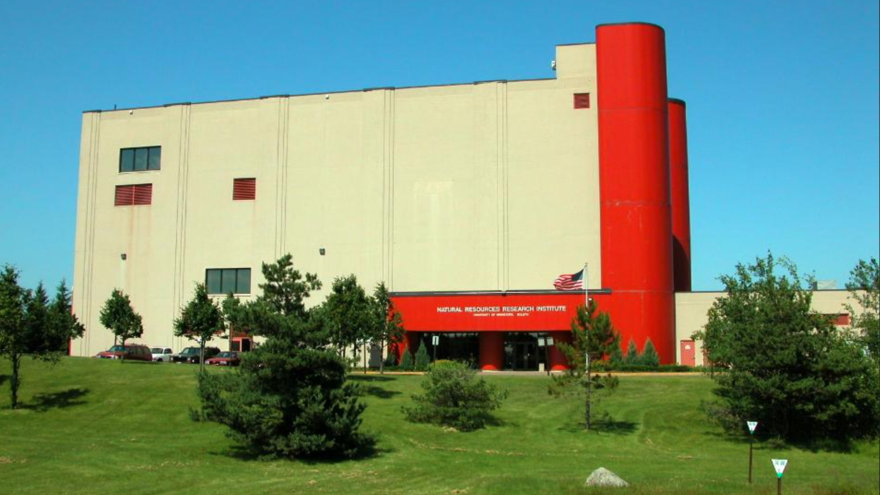
LED retrofits completed at both NRRI and the Darland Administration building are already showing huge energy savings.
Based on the 2020 greenhouse gas (GHG) inventory, conducted by the Office of Sustainability, 52.1% of our GHG emissions come from electricity use. So when we think about reducing GHG emissions, reducing our electricity consumption is very important. Replacing old inefficient CFL, or Incandescent bulbs with long-lasting, energy-efficient LED bulbs is a great step forward in reducing campus electricity consumption and GHG emissions.
Back in 2019, UMD began a complete campus LED retrofit. The goal, to replace every light bulb and fixture throughout campus with LED lighting. The Natural Resource Research Institute (NRRI), and the Darland Administration buildings were first on the list. NRRI was to receive a complete LED retrofit along with occupancy controls in the stairwells to reduce lighting during times of no occupancy. The plan for Darland was to not only replace the interior lighting but the exteriors as well. Fortunately, workers were able to complete these two buildings before UMD administration put the rest of the project on hold due to an uncertain budget and safety concerns caused by the COVID-19 pandemic. About a year later, approval was received to continue the project and use the Green Revolving Fund to purchase LED lighting for UMD’s main corridor from Concourse A down to the Swenson College of Science and Engineering. Electricians will be working on that project for the next couple of months. Meanwhile, housing is working to replace corridor lighting in Griggs P, Q, R, and S. The future of the rest of the campus retrofit is still unclear.
The two completed buildings have already had a huge impact on reducing campus energy consumption and GHG emissions. Rebates from Minnesota Power show that the NRRI retrofit reduced the building's annual electricity use by nearly 212 MWh, saving $17,750 a year. Darland’s interior and exterior lighting replacements have reduced the building's annual electricity use by 109 MWh, with yearly savings of $9,680. The estimated payback periods for NRRI and Darland are 8.55 and 8.39 years respectively. In total these two projects reduce campus electricity use by roughly 321 MWh a year, the equivalent to the average yearly consumption of 30 American households.
Why LEDs?
LED bulbs have a much higher lumen efficacy than CFLs or incandescents which means they require much less wattage to achieve the same level of brightness which is why LEDs are more energy-efficient and longer-lasting than their competitors. On average, CFLs require nearly 2 times as much wattage to reach the same level of brightness as LEDs. For incandescents, it can be up to 5 times as much! This means that for every hour your non-LED bulb is on, you are using 2-5 times as much energy as you would using an LED light source. By reducing your electricity use you will not only be reducing your GHG emissions but you will save money as well. Additional cost savings associated with LEDs comes from the longer lifespan. On average 1 LED bulb will last for 25,000 hours. You would need to buy 3 CFL bulbs or 21 incandescent bulbs to achieve the same lifespan. Even though LEDs tend to cost more per bulb than their competitors, they are still the more cost-effective long-term choice. The total estimated 20-year cost of buying and operating only LEDs is nearly 40% less than CFLs and over 80% less than that of incandescents.
|
Light Source |
Efficacy (Lumens/Watts) |
Average lifespan (hours) |
Average cost per bulb |
Total estimate 20-year cost |
|
LED |
30-90 |
25,000 |
$5 |
$34 |
|
CFL |
16-24 |
8,000 |
$2 |
$54 |
|
Incandescent |
12-18 |
1,200 |
$1 |
$211 |
Choosing the right bulb:
LEDs can vary greatly in size, wattage, and color temperature. The color temperature of a bulb lets us know what the look and feel of the light emitted will be and is measured in degrees Kelvin. Typically, the Kelvin rating used for commercial and residential LED lighting projects range between 2,000K and 6,500K. Knowing the rating of a bulb can help you determine the best location for installation.
|
Kelvin Rating |
2,000K-3,000K |
3,100K-4,500K |
4,500K-6,500K |
|
Light Appearance |
Warm White |
Cool White |
Daylight |
|
Associated effects and moods |
Cozy, calm, relaxing |
Bright, vibrant, welcoming |
Crisp, refreshing |
|
Residential |
Living rooms, bedroom, dining areas |
Bathrooms, laundry room, home office, kitchen |
Task light, garage, basement, attic |
|
Commercial |
Lobby, coffee shops, bookstores |
Office, meeting rooms, classrooms, bathrooms |
Labs, warehouses, commercial kitchens, garages, medical rooms |